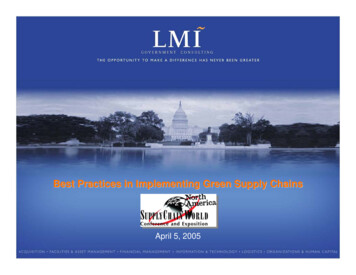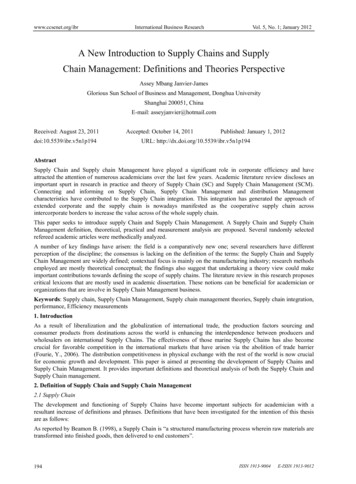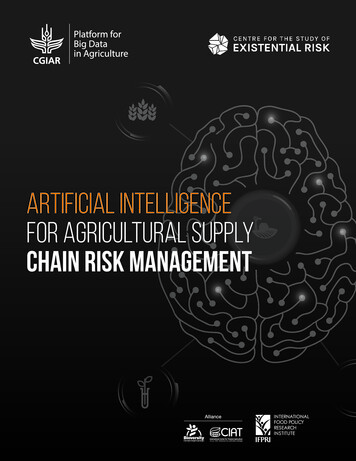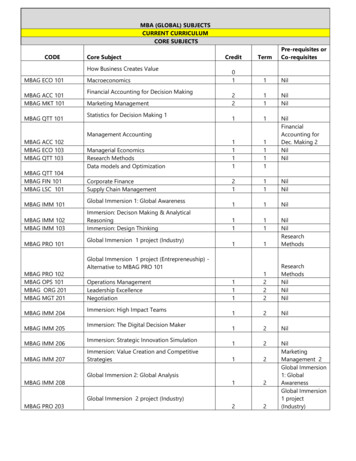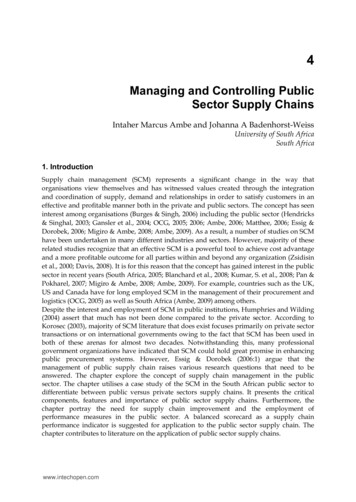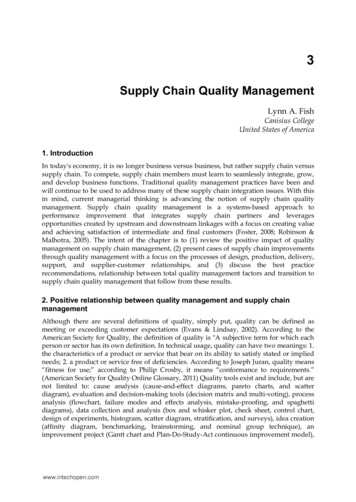
Transcription
3Supply Chain Quality ManagementLynn A. FishCanisius CollegeUnited States of America1. IntroductionIn today's economy, it is no longer business versus business, but rather supply chain versussupply chain. To compete, supply chain members must learn to seamlessly integrate, grow,and develop business functions. Traditional quality management practices have been andwill continue to be used to address many of these supply chain integration issues. With thisin mind, current managerial thinking is advancing the notion of supply chain qualitymanagement. Supply chain quality management is a systems-based approach toperformance improvement that integrates supply chain partners and leveragesopportunities created by upstream and downstream linkages with a focus on creating valueand achieving satisfaction of intermediate and final customers (Foster, 2008; Robinson &Malhotra, 2005). The intent of the chapter is to (1) review the positive impact of qualitymanagement on supply chain management, (2) present cases of supply chain improvementsthrough quality management with a focus on the processes of design, production, delivery,support, and supplier-customer relationships, and (3) discuss the best practicerecommendations, relationship between total quality management factors and transition tosupply chain quality management that follow from these results.2. Positive relationship between quality management and supply chainmanagementAlthough there are several definitions of quality, simply put, quality can be defined asmeeting or exceeding customer expectations (Evans & Lindsay, 2002). According to theAmerican Society for Quality, the definition of quality is "A subjective term for which eachperson or sector has its own definition. In technical usage, quality can have two meanings: 1.the characteristics of a product or service that bear on its ability to satisfy stated or impliedneeds; 2. a product or service free of deficiencies. According to Joseph Juran, quality means“fitness for use;” according to Philip Crosby, it means “conformance to requirements.”(American Society for Quality Online Glossary, 2011) Quality tools exist and include, but arenot limited to: cause analysis (cause-and-effect diagrams, pareto charts, and scatterdiagram), evaluation and decision-making tools (decision matrix and multi-voting), processanalysis (flowchart, failure modes and effects analysis, mistake-proofing, and spaghettidiagrams), data collection and analysis (box and whisker plot, check sheet, control chart,design of experiments, histogram, scatter diagram, stratification, and surveys), idea creation(affinity diagram, benchmarking, brainstorming, and nominal group technique), animprovement project (Gantt chart and Plan-Do-Study-Act continuous improvement model),www.intechopen.com
26Supply Chain Management – Pathways for Research and Practiceand management tools (relations diagram, tree diagram, matrix diagram, L-shaped matrix,arrow diagram, and process decision program chart) (Tague, 2004).Total quality management is a set of quality practices that seek to continuously improvequality in processes. The eight key principles of total quality include (Monczka et al., 2009):1. Define quality in terms of customers and their requirements.2. Pursue quality at the source.3. Stress objective rather than subjective analysis.4. Emphasize prevention rather than detection of defects.5. Focus on process rather than output.6. Strive for zero defects.7. Establish continuous improvement as a way of life.8. Make quality everyone's responsibility.Supply chain management is an approach to integrating suppliers, manufacturers,distributors and retailers, such that products are produced and distributed at the rightquantities, to the right location, at the right time, with the mutual goals of minimizingsystem wide costs and satisfying customer service requirements (Simchi-Levi et al., 2008).In other words, supply chain management synchronizes a firm's processes with its suppliersand customers with the goal of matching the materials, services and information withcustomer demand (Krajewski et al., 2010). Critical supply chain processes include productdesign, production, delivery, support, and supplier-customer relationships. To succeed intoday's environment, managers need to integrate their goals effectively to compete in thedynamic, global economy and focus on the final customer as the driver for improvements.Supply chains compete based upon cost, quality, time and responsiveness. Supply chainimprovement tools include, but are not limited to process improvement tools of flowcharting, flow diagrams, service blueprints, process analysis, process re-engineering, linkcharts, multi-activity analysis, backward chaining, and Gantt charts.Quality is one of the most important factors for companies in their relationship betweensuppliers and customers. In fact, quality is so critical that today's executives questionwhether their companies should be participating in global sourcing as many globalsuppliers are not able to meet quality requirements (Brockwell, 2011). Positive relationshipsbetween quality management and supply chain management exist. To begin, qualitymanagement improvements in reducing process variation directly impact on several supplychain performance measures. With continuous quality management improvement, defects and therefore, process and production variation, are reduced. In turn, as consistency in thesupply chain improves due to the variation reduction, cycle times are reduced (the timebetween two successive replenishments) and on-time delivery improves (Flynn & Flynn,2005).Quality management practices, such as design for manufacturability, whereby product andprocess decisions are developing in new products simultaneously, and effective productdesigns geared toward the final customer requirements result in less product and processvariation. While variance reduction in the processes obviously leads to qualityimprovements, consideration to the processes used during design enables management toswitch from one product to another quicker. Therefore, design for manufacturability leadsto quicker setup times between products (Flynn & Flynn, 2005). Quicker setup times allowscompanies to reduce lot sizes as less cycle (inventory needed between two successivereplenishments) and safety stock (the amount of inventory required to protect againstdeviations from average demand during lead time) is required (Simchi-Levi et al, 2008).www.intechopen.com
Supply Chain Quality Management27As fewer defects are created, the amount of inventory in the supply chain is reduced.Supply chain members move only 'good' units, and not 'defective' units through the supplychain. Quality management practices reduce process variance, which has a direct impact onsupply chain performance measures, such as inventory and time measures (Flynn & Flynn,2005). As process variation is reduced, leading to more quality units and fewer defectiveunit moving through the supply chain, the cycle time will also improve. With fewerdefective units moving through the supply chain, delivery dependability improves.Similarly, cycle time improvements result in less inventory 'in the way' of supply chainmovement as there is less need for safety and cycle stock inventory, and fewer defectiveunits need to be scrapped or replaced (Simchi-Levi et al., 2008).Quality efforts to reduce variation have many positive results, including pipeline inventoryreduction (Flynn & Flynn, 2005). Pipeline inventory (the amount of inventory betweenmembers of the supply channel including work in process inventories between manufacturingoperations) is held as a function of manufacturing, supply and delivery cycle times. Throughquality management, as the number of defects in the supply chain decreases and cycle timesare shortened, simultaneously the total and pipeline inventory are reduced (Simchi-Levi et al,2008). As already noted, pipeline inventory is also improved through variance reduction.A quality improvement leading to a reduction in defective units, and therefore a reductionin rework, has a positive impact upon the supply chain as cycle times are reduced,schedules are met and customer response times improve (Flynn et al., 1995; Mefford, 1989).Fewer defective units in the system allow the remaining units to move through the supplychain faster, which is noted by improved cycle times. As companies are able to moveproduct faster through the supply chain, schedules and the customers' demands can be metfaster. This allows an improved synchronization and integration across the entire supplychain (Ferdows et al., 2004).The adage 'garbage in, garbage out' advocates strong relationships between suppliers andbuyers with respect to quality. Supplier certification programs and registration systems,such as ISO9000, assist companies to obtain quality items at the source. Prompt andreasonable supplier feedback also assists with providing quality inputs to the system.Utilizing statistical process controls throughout the supply chain aids in variation reduction,ensures quality inputs and reduces work-in-process in the supply chain system. Quality atthe source, feedback and process controls ensure quality throughput in the system andtherefore, reduces inspection time for raw materials, in-process inventory, and finishedgoods (Flynn & Flynn, 2005). The end result of supplier certification programs is less time isneeded to stop the product and inspect for 'quality', which in turn, reduces cycle andtransportation times (Heiko, 1990).Constantly changing suppliers merely due to price, increases the variation in the materialsand time elements for the supply chain. Product variation and information accuracy isnegatively impacted. Certified suppliers and long-term relationships can positively impacton both quality and supply chain initiatives (Heiko, 1990; Kaynak & Hartley, 2008; Trent &Monczka, 1999). In these relationships, suppliers and buyers reap joint improvement drivenby mutual interdependence, open and complete exchange of information, and win-winshared rewards. In these relationships, due to improved and increased exchange ofinformation, supplier's product design changes are minimized, visibility to future purchasevolume requirements is increased, and access and visibility to new product requirements isimproved. Suppliers gain from a reduction in new product development time, productionlead time, ethical treatment, and accurate, timely payment of invoices.www.intechopen.com
28Supply Chain Management – Pathways for Research and PracticeTo summarize, quality management practices are associated with supply chain performanceimprovements. Therefore, quality management and supply chain management strategicgoals and initiatives need to be pursued simultaneously as customers drive supply chainmanagement and quality initiatives.3. Quality and supply chain improvementAs discussed, there is a positive and direct relationship between quality and supply chainmanagement. While the quality management movement started in the United States in the1970's, the supply chain management movement is much 'younger', gaining momentumwith the turn of the 21st century. Within a supply chain, important business processes affectcustomer satisfaction: design, production, delivery, support, and supplier-customerrelationship processes. What quality techniques and tools are available to drive supply chainmanagement improvements?3.1 DesignWe continue with a discussion of several cases whereby quality methods were instrumentalin supply chain management improvements, starting with the design process. The designprocess, which is critical for company and supply chain survival, includes all activities thattranslate customer requirements, new technology and past learning into functionalspecifications for a product, process, or service. With supply chains growing to includeglobal partners, time elements squeezing the quality attributes of items and developmentspeed increasing, it is not surprising that the design process has received considerableattention in the past decade. It is imperative that the products and processes to deliver theitem to the final customer are jointly designed. A wide variety of quality methods can beused to improve supply chains during the design phase including concurrent engineering,design for assembly, value engineering, and quality function deployment.Simultaneous, or concurrent, design of products and processes within companies, under theumbrella of concurrent engineering has been successful in product design at Intel andMicrosoft. Concurrent engineering, which brings together various functional specialists, is aprocess to bridge the gap between design and manufacturing with the goal of shorteningtime to market and improving quality. As supply chain management competition increases,a current design trend is to draw upstream suppliers into the new product developmentprocesses (which we will address in greater depth shortly). Due to technological andinnovation demands, supply chain concurrent engineering, for products such as electriccars, required suppliers further up the supply chain (beyond Tier 1 suppliers) to participatein the design process to increase competitiveness, reduce time to market and increasequality (Pilkington & Dyerson, 2002). As supply chains increase participation of all membersin design efforts, it is imperative that hidden costs of new product developmentacceleration, such as the form of skipping steps - particularly information communicationand allocation of resources toward non-profitable, trivial innovation that drives out moreprofitable ones, be carefully monitored. Also, it is imperative that during the design phase,splitting design and production of coupled processes should be avoided.Design for manufacturability provides a method for designing parts that are easy tomanufacture and assemble, with cost and cycle time reduction and quality improvements asa result. Continuing in this vein of simultaneous activity, an emphasis on synchronizingwww.intechopen.com
Supply Chain Quality Management29product design decisions with supply chain management decisions, extends the concept ofdesign for assembly to 'design for supply chain' (Hulta & Swan, 2003; Joglekar & Rosenthal,2003; Lee & Sasser, 1995) and 'design for logistics' (Simchi-Levi et al., 2008). Design forsupply chain addresses the simultaneous design for materials across the different supplychain levels, while design for logistics emphasizes consideration during design to theprocesses used to move the items through the supply chain, such as packaging,transportation, timing of value-added processes and standardization. Using design formanufacturability, the automotive industry analyzed the make/buy decision with a focuson supply chain processes which resulted in product and production capabilityoptimization, concluded that simpler products should be outsourced while complex designsremain in-house, and supported the strategic importance of the product in the make/buydecision (Novak & Eppinger, 2001).Value engineering, a disciplined approach to eliminating waste from products andprocesses (APICS, 2002), can positively impact upon both supplier and buyer’s bottom-lineas demonstrated by the automotive industry where sharing information strengthened therelationship, reduced time to market, improved product quality and reduced costs (Blaney,2005). Correspondingly, due to the lack of information sharing and value engineeringpractices, a 'cut-throat attitude' continues to penetrate the construction industry (Blaney,2005). Extending value engineering to the supply chain should include evaluating all supplychain processes and not just a single process. As an example, Schneider Electric, a globalelectrical equipment manufacturer, jointly partners with their suppliers to achieve beneficialproduct results as well as significant supply chain cost, quality and time improvements(Avery, 2002). Joint value engineering efforts resulted in a material change for thecomponent, resulting in cost savings for both members and a quality improvement.Quality Function Deployment, a methodology to match the customer’s needs withtechnological capabilities, has proven to be beneficial in designing products such as the 1992Cadillac, and for companies such as Ford, General Motors, Motorola, and AT&T (Evans &Lindsay, 2002). Extension to the supply chain involves using Quality Function Deploymentacross supplier-customer boundaries to capture the final customer’s voice and integrate itwith supply chain processes. Japanese managers also indicate that the Quality FunctionDeployment process itself can be utilized to improve supply chain quality, technologymanagement, and supply chain operating initiatives (Chu-Hua et al., 2002).As previously noted, while supplier-customer integration across the supply chain for allprocesses is a major trend, integration in the design process can lead to cost reduction,supply chain competitiveness and improvements in quality, product safety, resourceplanning and materials management. John Deere and Motorola's highly successful newproduct development are well-known cases in this area. At John Deere, through the supplierdevelopment engineering program, a significant cost reduction resulted; however, suppliersand John Deere noted that all members must share technology, risk and accountability.Similarly at Motorola, the need for design resources and a focus on costs were emphasized.Integration typically involves organizational changes including cross-functional integrationof multifunctional teams and supplier advisory councils. While a trend in supply chainmanagement is toward strategic sourcing, the question of when to incorporate suppliers intonew product development is still debatable. Early supplier design involvement is aconcurrent engineering approach between suppliers and buyers that takes advantage of thesupplier's design capabilities. Suncor Energy utilized internal personnel, contractors andsuppliers to develop a unified strategy to address all phases of the product life cycle. Resultswww.intechopen.com
30Supply Chain Management – Pathways for Research and Practiceindicate a cost reduction, planning and cycle time reduction, and a significant success rate inwells drilled (Monczka et al., 2009). The results highlight the need to develop a unified, jointstrategy and importance of communication.3.2 Production/ delivery, and support processesWe continue our discussion by highlighting the integration of quality and supply chainmanagement improvements during the production, delivery and support processes. Theproduction process is responsible for manufacturing the product from inputs throughprocesses to outputs, while delivery processes are responsible for delivery of the product tothe customer. Support process, although they do not add direct value to the product,provide an infrastructure for the core processes. Useful quality management tools inproduction, delivery and support processes include (but are not limited to) processimprovement techniques, Six Sigma quality, performance measurement, Kaizen,benchmarking, value stream mapping, value analysis, and re-engineering.A quality management survey used in northern Italian businesses uncovered severalproblems including information communication issues, excessive repetition of technicalactivities and production configuration errors, that negatively impacted upon the companyand the supply chain members (Salvador & Forza, 2004). As a results, the order acquisitionand fulfillment processes were changed. Recently, Target Corporation used supplymanagement teams to develop a world-class supply base, reduce costs, improve cycle timesand accelerate time to market (Murphy, 2010). The team utilized various quality tools toevaluate value creation in the supply chain activities.A Six Sigma Quality Program, credited to Motorola, indicates that a process is in control towithin tolerance limits of /- 6 standard deviations from the centerline in control charting,which given natural process variation relates to 3.4 defects per million opportunities. SixSigma programs have been effectively utilized in services, manufacturing, education andgovernment. For example, Starwood Hotels utilized a Guest Satisfaction Index survey underits Six Sigma program to improve quality, reduce costs, increase speed and customerresponsiveness, and efficiency (Monczka et al., 2009). Similarly a printed circuit boardcompany's six sigma project to identify the root causes, key points and critical outputsresulted in changes to the production processes (Lee et al., 2009).Value analysis and value engineering are useful methods to improve the product, processesor both during new product development to ensure that the product or service fulfills itsintended function at the lowest total cost. Value analysis and value engineering wassuccessfully used in several industries, including the U.S. Department of Defense. At theU.S. Department of Defense, life cycle costs are reduced through value engineeringprocesses focused on low-cost systems for equipment, procedures, and supplies that aresafe, reliable, and maintainable (Benstin et al., 2011). Value analysis and value engineeringwere successful used in the chemical, plastic, electronic, transportation and packagingindustries to improve production performance, product quality, safety, and customerservice while reducing transaction costs and inventory costs.Benchmarking, whether informal or formal, is an effective method to improve quality,decrease costs, decrease lead time, improve dependability, and reduce shortages.Benchmarked firms improved their supply chains significantly on various measures overfirms that chose not to benchmark (Heizer & Render, 2006). Twenty-five years after thegrowth of benchmarking, a recent multinational survey of benchmarking practices indicateswww.intechopen.com
Supply Chain Quality Management31that benchmarking is still an effective improvement tool (Adebanjo et al., 2010). Abenchmarking study of supply chain processes from different industries that useddependency analysis and data envelopment analysis favored efficient supply chains ashigher financial performers (Reiner & Hofmann, 2006).3.3 Supplier-customer relationship managementSince purchased components account for over 55% of the cost of goods and suppliers areresponsible for over 50% of a firm's product quality problems, the relationship between thesupplier and buyer is critical. Quality is the most important factor for companies in theirrelationship between suppliers and customers (Sila et al., 2006). Therefore, supplier andcustomer relationship management processes can enhance or inhibit competition. Criticalprocesses to this relationship include communication, mutual assistance on new productdevelopment, and training. Strong relationships develop win-win relationships, trust,openness and honesty. However, this is easier said than done. As recently as the turn of thecentury at Whirlpool, little integration between supply chain members existed as differentlevels of the supply chain had different quality standards and goals (Roethlein et al., 2000).In fact, raw material providers did not understand where their products would finally endup, let alone the quality goals of members further down the chain.Supplier certification programs incorporate quality and delivery factors into the vendorselection process, which improves quality and delivery while reducing costs. Similarly,when applied to supply chain processes, a certification process assists with supplierselection and supply base optimization, a process to find the optimal number and mix ofsuppliers. At Alcoa, a world leader in aluminum and related products production, acomprehensive supplier certification program jointly improves quality and reduces costs forAlcoa and their suppliers (Monczka et al., 2009). As a follow-up to supplier selection,supplier performance rating systems assist with developing a stronger linkage betweensupplier and buyer through developing a win-win relationship for both partners, and assistwith standardizing and homogenizing quality goals throughout the supply chain. Processimprovements also assist with communication improvements to communicate qualityrequirements with suppliers, and using performance measurement systems, supplierimprovement programs can be developed.Improvements to the supplier-customer relationship management exist in the eight keyprinciples of Total Quality Management. To begin, communication of quality requirementsfrom the buyer in term of final customers is critical. Supplier certification processes assistwith pursuing quality at the source, while statistical quality controls can monitor andcontrol product and process issues. Objective (measured) instead of subjective (opinionbased) facts should be shared between supply chain members. A system to monitor andcorrect defects throughout the supply chain, without pointing blame is imperative.Performance data should guide quality and supply chain improvements. With respect tosourcing, supply managers can use data to develop preferred supplier lists, providefeedback to current suppliers, and monitor and improve relationships, products andprocesses. Total Quality Management programs between suppliers and buyers should focuson prevention of defects, and product and process variance reduction through programssuch as supplier certification programs. Monitoring should shift from product monitoring toprocess monitoring for consistency and reducing variation. A working supplier evaluationand selection system, benchmarking, reduction of duplicated processes, and knowledgewww.intechopen.com
32Supply Chain Management – Pathways for Research and Practicetransfer between functional units and across member boundaries can assist with the shift toprocess evaluation. ISO9000, the Malcolm Baldrige National Quality Award, and similarawards are critical factors to consider in the selection system. Another critical aspect in thisrelationship is developing a viable measure and understanding by supply chain membersfor process capability. Supplier evaluation and supply base rationalization processes canassist with improving supply chain quality throughout the system as variation betweensuppliers is reduced and product quality can be improved. As previously discussed, valueanalysis and value engineering can assist in developing a culture of continuousimprovement throughout the supply chain. Similarly including - and rewarding, suppliersfor participation in improvement programs can enhance the relationship and reap benefitsfor both members. The supplier-buyer relationship between supply chain members requiresthat quality start at the top. That is, it is imperative that company visions, goals andstrategies be aligned for the betterment of both companies. Joint projects, shared technology,buyer-supplier councils, and collaborative relationships can enhance the relationship. Theend result is a culture of continuous improvement throughout the supply chain, and as aresult, a highly effective, competitive one.In recent years, supplier-buyer linkages, whose main purpose was to procure materials,have been extended into design, information exchange, special services, distribution andmarketing. Co-makership is a process whereby suppliers and buyers work to establish astrong partnership with a few suppliers based upon information sharing and trust (Flynn &Flynn, 2005). Co-makership efforts can reduce cycle time, increase inventory turnover and ahigher on-time delivery rate. Co-makership encourages quality management practiceutilization and supply chain improvements through supplier evaluation, supply basereduction to facilitate long-term relationships, collaboration on product design activities,and proactively managing quality and delivery of parts (Flynn & Flynn, 2005).3.4 Summary of quality and supply chain managementA recent study highlighted the similarities and differences between supply chain andoperations managers as to quality integration (Foster & Ogden, 2008). Supply chainmanagers emphasized using benchmarking, complaint resolution, design for theenvironment, Enterprise Resource Planning, supplier development, change management,focus groups and supply chain process improvement more than operations managers. Whileboth supply chain and operations managers realize the value of ISO9000, operationsmanagers emphasize this system slightly more than supply chain managers. Supply chainmanagement is focused on improving future performance, while operations managers areprocess-oriented. Supply chain management must move beyond its transactions cost-basedperspective focused on the buyer-supplier relationship. Since customers drive supply chainmanagement and quality management, integration of quality and supply chain goals willdevelop a more competitive organization. Integration difficulties arise due to a lack ofstructure, organizational culture, reward system, and amount or lack of communicationacross functions (Pagell, 2004).Our review highlights the various tools used in the key supply chain processes of design,production, delivery, support and supplier-customer relationship management, and revealsthat traditional quality management practices applied to process management hold the keyto addressing supply chain management issues. While in the past supply chain managersand operations managers approached quality differently, in order to be competitive, today'swww.intechopen.com
Supply Chain Quality Management33practices must be inter-organizational, quality and supply chain oriented. There is a need toadvance current thinking from traditional firm-centric and a product-based mindset to aninter-organizational supply chain involving customers, suppliers, and partners. Therefore,quality and supply chain management need to be inte
improvements. Therefore, quality management and supply chain management strategic goals and initiatives need to be pursued simultaneously as customers drive supply chain management and quality initiatives. 3. Quality and supply chain improvement As discussed, there is a positive and direct relationship between qu ality and supply chain management.




